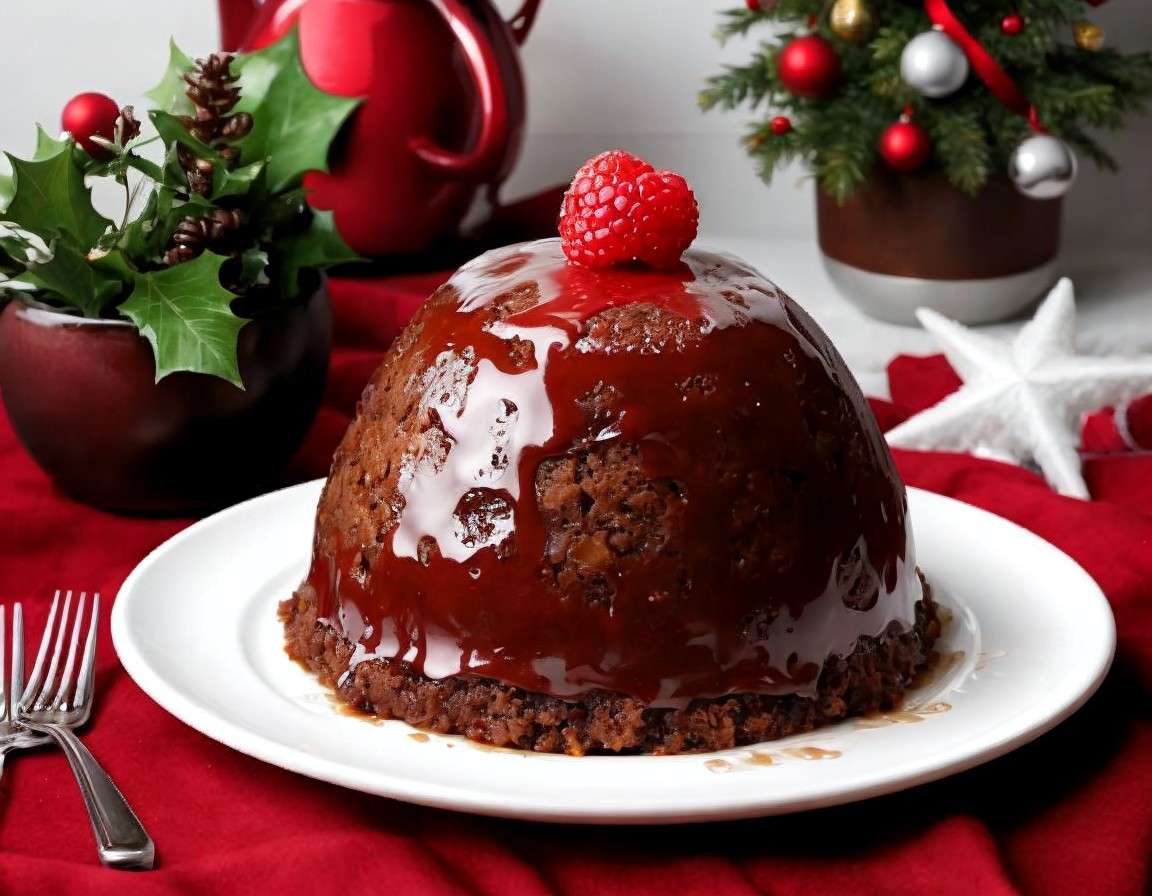You’re about to uncover the rich history and evolution of Christmas pudding and other beloved holiday foods, from their medieval roots to modern-day twists. In medieval Britain, plum pudding was a staple at festive feasts, showcasing the host’s wealth and status with its exotic ingredients. The Victorian era refined the recipe, making it accessible to the masses. Cultural exchange later infused global flavors, resulting in distinct regional profiles. As you explore the history of Christmas pudding, you’ll discover how sugar, spices, and seasonal traditions have shaped this beloved holiday treat, and you’ll find yourself curious about what other secrets lie ahead.
Key Takeaways
- Medieval Britain’s winter solstice celebrations featured plum pudding, a dense, heavy mixture of dried fruits, nuts, and spices, served with sweet sauce.
- The Victorian era transformed plum pudding into a refined and accessible treat, paving the way for elaborate desserts like trifles and charlottes.
- Cultural exchange has shaped the flavors and ingredients of Christmas pudding, resulting in distinct regional flavor profiles around the world.
- Classic holiday treats like Christmas pudding have undergone significant transformations over time, with innovative twists and adaptations to cater to diverse tastes.
- The combination of sweet and savory flavors, infused with warm spices, has remained a hallmark of Christmas pudding, a beloved holiday tradition for centuries.
Medieval Roots of Christmas Pudding
During the Middle Ages, you likely would have found a precursor to Christmas pudding on the tables of wealthy British nobles, where it was served as a rich, fruity, and spicy concoction called ‘plum pudding.’ This indulgent dessert was a staple at Festive Feasts, particularly during the winter solstice celebrations.
Royal Recipes, passed down through generations, certified that plum pudding remained a beloved treat among the aristocracy.
You would have noticed that plum pudding was a far cry from the light, airy desserts we’re familiar with today. Instead, it was a dense, heavy mixture of dried fruits, nuts, and spices, often served with a sweet sauce.
The rich flavors and textures were a demonstration of the wealth and status of the host, as only the most affluent could afford such exotic ingredients.
As you explored the kitchens of medieval castles, you might’ve caught a glimpse of cooks busily preparing plum pudding for the holiday season.
With its long history and regal connections, it’s little wonder that plum pudding evolved into the Christmas pudding we’re acquainted with today.
Its enduring popularity is a tribute to the power of tradition and the allure of festive flavors.
Victorian Era Influence on Sweets
Exploring the evolution of Christmas pudding, you’ll find that the Victorian era brought significant changes to the traditional sweet, transforming it into a more refined and accessible treat for the masses.
This period saw the rise of plum cakes, which became a staple in many British households. These rich, fruity delights were often served at holiday gatherings, and their popularity paved the way for more elaborate desserts.
During this time, fancy desserts like trifles and charlottes became all the rage. These multi-layered masterpieces consisted of sweet biscuits, fruits, and creamy custards, showcasing the era’s love for opulence and extravagance.
As a result, Christmas pudding underwent a transformation, incorporating these new elements to create a more sophisticated and visually appealing treat.
The Victorian era’s influence on sweets also led to the development of new cooking techniques and ingredients. The introduction of sugar, spices, and nuts enabled bakers to create more complex and nuanced flavors.
This, in turn, elevated the status of Christmas pudding from a humble, homemade treat to a luxurious centerpiece for holiday feasts.
Cultural Exchange and Holiday Flavors
As you move beyond the Victorian era’s ornate desserts, you’ll discover that cultural exchange played a significant role in shaping the flavors and ingredients of Christmas pudding.
The tradition of Christmas pudding-making was influenced by global fusion, with different cultures bringing their unique flavors and ingredients to the table.
As a result, you’ll find that Christmas puddings around the world have distinct flavor profiles. In the Caribbean, for instance, you’ll find puddings infused with rum and spices, while in Europe, they’re often made with dried fruits and nuts.
In Asia, Christmas puddings might incorporate ingredients like ginger and coconut.
This cultural exchange has led to a rich diversity of flavors, making each region’s Christmas pudding a true reflection of its heritage.
When you taste a Christmas pudding, you’re experiencing a flavor profile that’s been shaped by centuries of cultural exchange.
Evolution of Classic Holiday Treats
You’ve likely noticed that classic holiday treats, like Christmas pudding, have undergone significant transformations over time, adapting to changing tastes and ingredient availability.
This evolution is a reflection of the dynamic nature of holiday cuisine, where traditional recipes are reimagined to suit modern palates.
Holiday adaptations have led to innovative twists on beloved treats, making them more accessible and appealing to a wider audience.
For instance, Christmas pudding has seen variations in ingredients, such as the addition of nuts, chocolate, and spices, to cater to diverse tastes.
Food innovations have also played a vital role, enabling the creation of new textures, flavors, and presentation styles.
The rise of vegan and gluten-free alternatives has further expanded the range of holiday treats, ensuring that everyone can participate in the festive feasting.
These changes not only reflect shifting culinary trends but also demonstrate the adaptability and creativity of holiday cooking.
As you indulge in your favorite holiday treats this season, remember the rich history and evolution that have shaped these delicious traditions.
Sugar, Spices, and Seasonal Traditions
When you slice into a rich, fruit-laden Christmas pudding, the sweet aroma of sugar and spices instantly transports you to a world of seasonal traditions, where festive flavors evoke memories of winter celebrations past.
The combination of sweet and savory flavors is a hallmark of winter classics, and Christmas pudding is no exception. The dense, moist texture is infused with the warmth of spices like cinnamon, nutmeg, and cloves, which add depth to the fruit and sweetness.
As you take a bite, the flavor profiles of the pudding unfold, revealing notes of citrus, cherries, and raisins.
The spices, carefully balanced to avoid overpowering the other ingredients, add a subtle warmth that complements the richness of the fruit. It’s no wonder that Christmas pudding has remained a beloved holiday tradition for centuries.
Whether served with brandy butter or whipped cream, this sweet treat is sure to evoke memories of winter celebrations past and create new ones with family and friends.
Frequently Asked Questions
What Is the Origin of the Christmas Pudding’s Flaming Tradition?
You might wonder why Christmas pudding is always flambéed; it’s rooted in British Heritage from the Victorian Era, where brandy was poured over the dish to symbolize Christ’s life and the Holy Spirit, creating a dazzling spectacle.
Are There Any Vegan or Gluten-Free Alternatives to Traditional Holiday Treats?
As you deck the halls, you’re probably craving sweet treats that fit your dietary needs. Fear not, festive friend! You can indulge in vegan substitutes like coconut milk and gluten-free baking flours to create merry, mouthwatering masterpieces.
Can Christmas Cookies Be Made Ahead of Time and Frozen?
You can definitely make Christmas cookies ahead of time and freeze them, but pay attention to cookie consistency before freezing. Follow freezer tips like wrapping tightly and labeling to guarantee they stay fresh and delicious when you’re ready to bake.
What Is the Significance of Serving Certain Foods on New Year’s Eve?
You’re curious about the significance of serving certain foods on New Year’s Eve! In many cultures, you’ll find Lucky Foods like lentils, fish, and grapes being served, as they’re believed to bring good fortune and prosperity in the coming year, often becoming cherished Family Traditions.
How Did Holiday Foods Become Associated With Specific Winter Holidays?
You hop on a time machine to ancient civilizations, where cultural exchange and seasonal availability inspired holiday food traditions. As you travel, you’ll discover how festive dishes became synonymous with winter celebrations, like Christmas pudding and more.
Conclusion
As you savor the last bite of Christmas pudding, remember that you’re part of a centuries-old tradition.
Like Ebenezer Scrooge, you’ve traveled through time, witnessing the evolution of holiday treats.
From medieval roots to Victorian influences, cultural exchange, and seasonal traditions, the flavors and ingredients have blended like a rich fruitcake.
Now, as you look forward to the next holiday gathering, you’re not just indulging in sweet treats – you’re continuing a story that’s been unfolding for centuries, one delicious chapter at a time.


